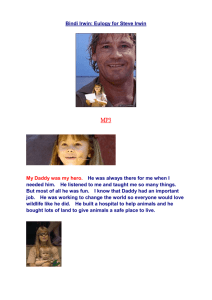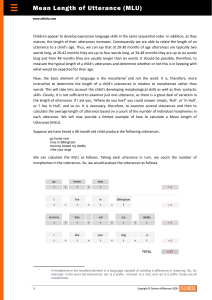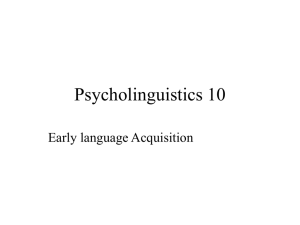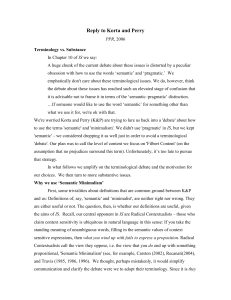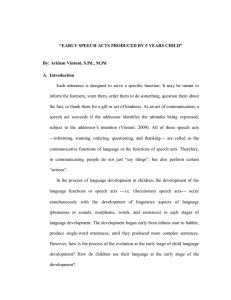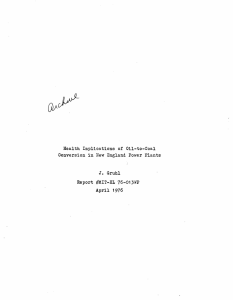Communication Development from Birth to Two Years Reception
advertisement
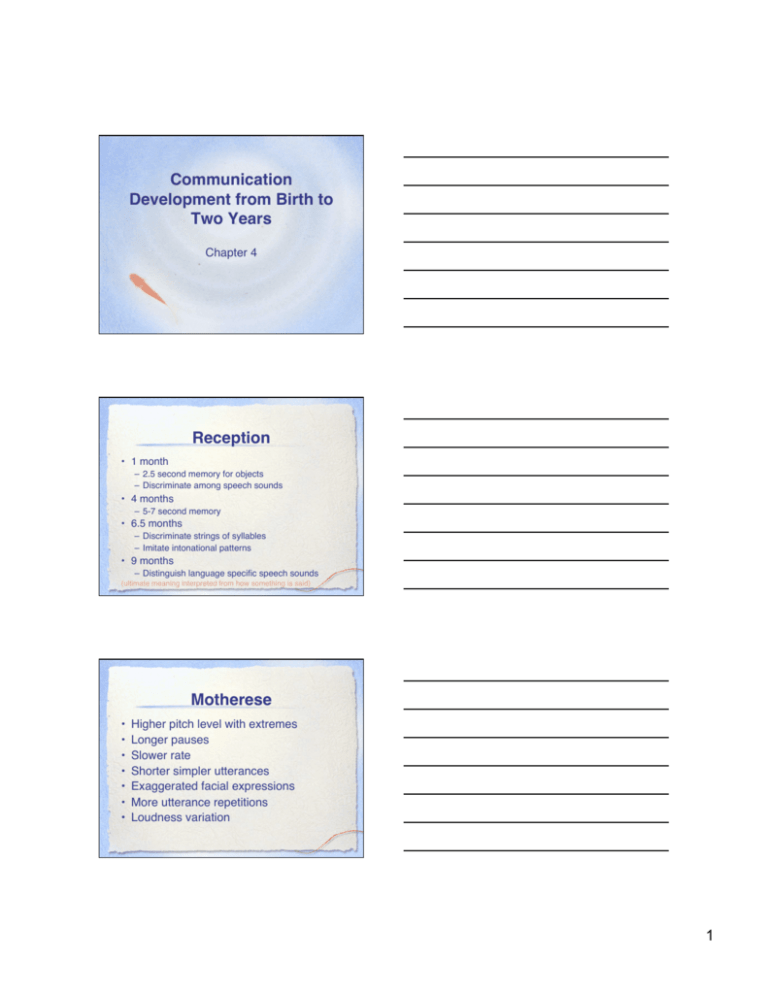
Communication Development from Birth to Two Years Chapter 4 Reception • 1 month – 2.5 second memory for objects – Discriminate among speech sounds • 4 months – 5-7 second memory • 6.5 months – Discriminate strings of syllables – Imitate intonational patterns • 9 months – Distinguish language specific speech sounds (ultimate meaning interpreted from how something is said) Motherese • • • • • • • Higher pitch level with extremes Longer pauses Slower rate Shorter simpler utterances Exaggerated facial expressions More utterance repetitions Loudness variation 1 Joint Reference 1. 4-6 weeks - puts object in front of child with “look” (begins to respond to tone) 2. 7 months - child points to object of interest (begins to reach) 3. 8-12 months - gestures and vocalizations combined to indicate object 4. 12 months - child controls topic (names object and event) Expression 1. 2. 3. 4. 5. 6. Reflexive cries and noises Comfort and pleasure sounds Transitional babbling Reduplicated babbling (echolalia) Variegated babbling/jargon Protowords (vocables, phonetically consistent forms, performatives) Conversation • Perlocution (birth-8 months)unintentional and nonverbal • Illocution (8-12 months)- intentional but nonverbal • Locution (beyond 1 year) - intentional and verbal 2 Mean Length of Utterance Stage Description Age MLU 1 Semantic roles and grammatical relations 12-26 1.0-2.0 2 Grammatical morphemes and modulation of meaning 27-30 2.0-2.5 0 3 Modalities of simple sentence 31-34 2.5-3.0 4 Embedding of sentences 35-40 3.0-3.7 5 5 Coordination of simple sentences and propositional relations 41-46 3.75-4. 50 Brown’s (1973) Stages of Syntactic Development Stage 1 - Words to Combinations of Words Early 1 (1-1.5 MLU; 12-22 mos) • 1st word (12 months) – Reference to something important to them – Usually one syllable (“up”), or one syllable repeated (“mama”) – Usually CV, VC, or CVCV 3 “dog” Overgeneralization “apple” Undergeneralization Semantic Feature Hypothesis • Clark, 1975 • Classified based on percepts (size, shape) • Interpretation of each word is based on a collection of semantic features • Nothing else possesses all of the features “dog” – Animal, furry, four legs, wet nose, tail, barks 4 Functional Core Hypothesis • Nelson (1974) • Classified based on functions or actions of things • Animate/inanimate; can be eaten, etc. “dog” – animate, can eat, but may not be eaten, can bark but can’t talk Prototype Hypothesis • Bowerman (1978) • Child relies on both perceptual features and functions in developing meaning • Select model (prototype) which best represents word for comparison • Continues throughout childhood into adulthood http://myfwc.com/marine/fish/atlspade.jpg http://www.madlantern.com/clipart/clips/Animals1/whale.gif First Words (Bloom, 1973) • Substantive words - – Classes with perceptual of functional features in common – “mama”, “doggie”; “kitty” – Further divided based on action – Agents and objects • Relational words – Actions or states of being – “allgone”, “bye-bye”, “stop”, “no”, “more” 5 First Words (Nelson, 1973) • First 50 words 1. 2. 3. 4. 5. 6. General nominals Specific nominals Action words Modifiers Personal-social words Function words (7 or 14%) (25-26 or 51%) (6-7 or 13%) (4-5 or 9%) (4 or 8%) (2 or 4%) Use/Function • communicative functions (Halliday, 1975)/ primitive speech acts (Dore, 1975) • Child uses single word to accomplish great deal “cookie” - can be used to mean – I want one – That’s not one (in response to sugar wafer) – I don’t want one – Etc. Use/Function • communicative functions (Halliday, 1975) – – – – – – – Interacting Regulatory Personal Heuristic Instrumental Imagine (pretend) Informative/labeling • primitive speech acts (Dore, 1975) – – – – – – – – – Labeling Answering Requesting an action Requesting an answer Calling Greeting Protesting Repeating/Imitating Practicing 6 Early Skills • Presuppositions – Assumption regarding what a listener already knows – Begins at single word level and continues through school age • Conversational Turn-Taking – Begins before first word with games/rituals (“peek-a-boo”) Late 1 (1.5-2 MLU; 22-26 mos) • Refine 2 word utterances – First appears around 18 months – Considered on three levels • Syntactic • Semantic • Pragmatic Syntax • Pivot-Open Grammar (Braine, 1963) – “that ball”, “that cookie”, “that mama” • Communicative Context (Bloom, 1973) – One must consider context to determine how utterance is being used 7 Semantics • As in 1 word utterances, interpretation remains difficult (always depends on context) • Begins to use syntax to aid meaning – Talk about things – Where they are – What actions they perform – What actions are performed on them – Who creates these actions Pragmatics • To previous functions child adds – Pragmatic function - uses language to get things done – Mathetic function - used to learn about self and world – Informative function - give new information to others Pragmatics • Basic rules of conversation 1. Gain partners attention before speaking 2. Listen before speaking 3. Take turns 8 Emerging Language Factors • Strong biological drive to learn language • Emergence of language closely tied to cognitive development • Must have language models to acquire language Caregivers • Facilitate overall language (and vocabulary) development – Expands - expands into complete form “Daddy car” “Yes, that’s Daddy’s car.” – Extends - add new semantic information “Daddy car” “Yes, Daddy has a red car.” Review Questions • Complete all • Consider carefully – 4, 6, 7, 8, 12, 15, 19 9





